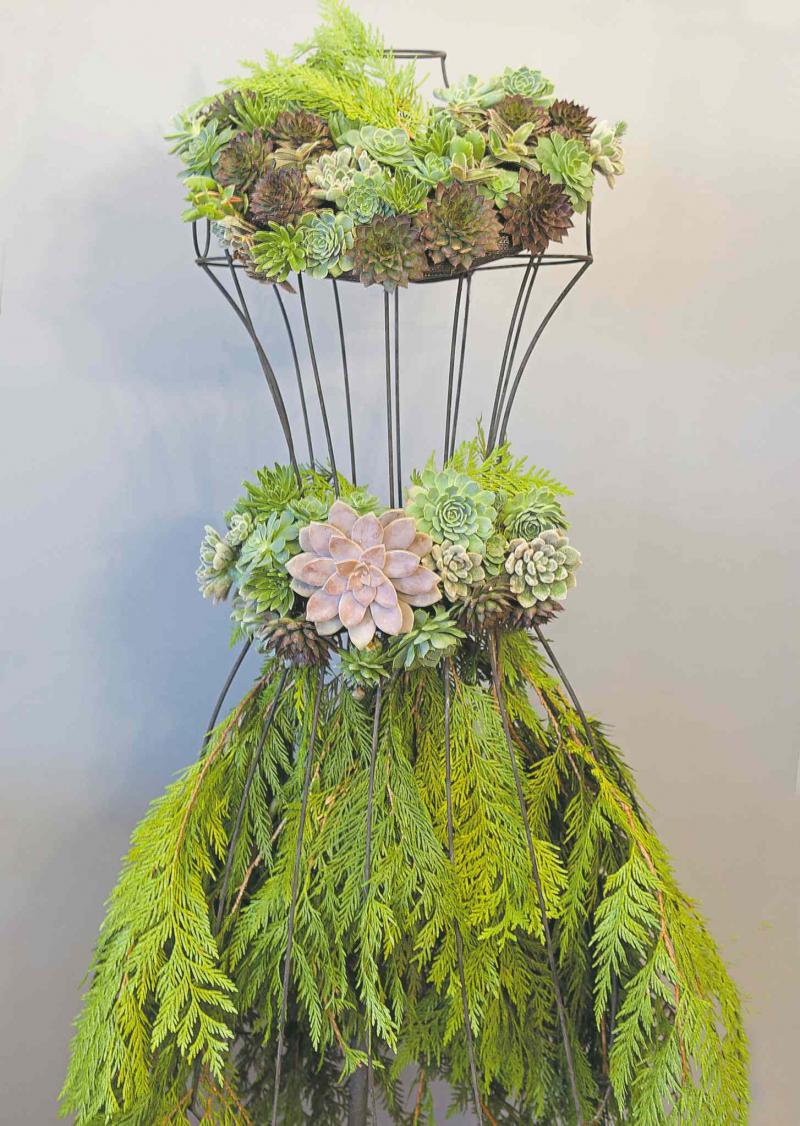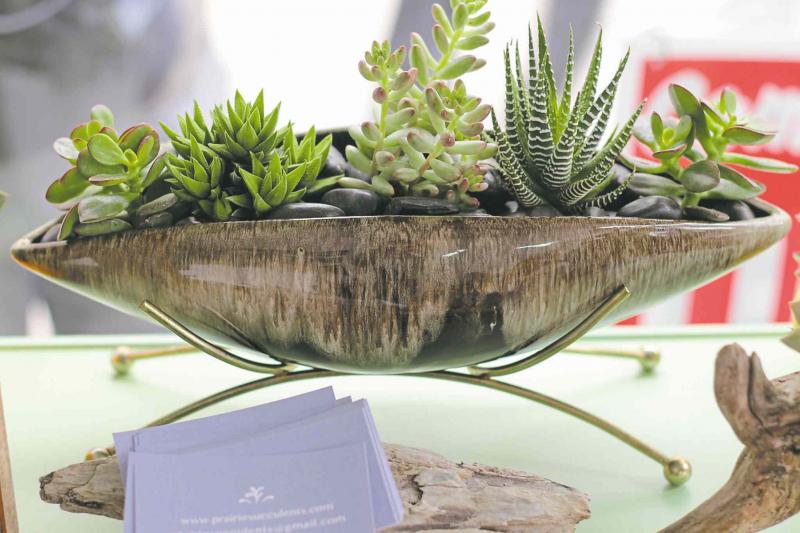

Sometimes, the best ideas are borne from the desire to do anything other than what's on our to-do list.
Can't find the motivation to get ready for the holidays? A creative boost might be all you need. Why not create a tapestry or mosaic of succulents? Your canvas can be as small as a teacup. Anita Trudel creates beautiful mosaics in whatever she can find, even wine corks.
Trudel, a 20-something who works full time while pursuing a master's degree in business administration, belongs to a new generation of gardeners who have fallen in love with succulents. From wedding favours to bouquets and boutonnieres, succulents are stepping out in style, suited as they are to a variety of unique applications, thanks to their shallow root system.
With little time to fuss and sometimes a smaller space to work with, it seems like a no-brainer for a busy person to opt for plants that easily adapt to an indoor environment but also thrive outdoors in the summertime on a balcony or small patio.
Trudel describes herself as a succulent addict and has plans to start a greenhouse and mail-order business. Like most gardeners, she started out with traditional containers to house her collection. As her collection grew, she evolved to upcycled and repurposed objects, sourced at thrift stores and vintage shops. Trudel has experimented with creating succulent-scapes in everything from gravy boats to pitchers.
Exposure on Etsy, an e-commerce website, created demand for her portable, miniature designs and her own website, www.prairiesucculents.com, soon followed. When I dropped into FLASH, a pop-up handmade and vintage boutique at the corner of Graham Avenue and Vaughan Street that is carrying Trudel's succulent creations, I identified my favourite instantly -- a small wooden treasure chest, a study in detail, its lid opened to reveal a mix of succulents artfully arranged with every appearance of gemstones spilling out.
While there are many interesting and unusual kinds of succulents, the most easily available and common types are the Echeverias and Sempervivums. Within these genera there are countless varieties from which to choose, in a wide range of forms and colours.
If you have ever admired a rose in bloom, then you will noted a certain similarity in form, if not in texture, in the echeveria rosette. With near perfect symmetry, the fleshy leaves of the echeveria are arranged in rows of fat, overlapping layers. Echeveria, though, is as tough as the rose bloom is fragile.
When working in your garden, have you ever accidentally dislodged one of the small baby rosettes from a sempervivum, either with your foot or a garden tool? It can easily happen, but just as easily the separated succulent can be stuck back in the ground to start anew.
Sempervivum tectorum is more commonly known as hens and chicks. In Latin, semper means forever and vivum means to live. Tectorum means 'of roofs' because they were often planted in early times on the tiled roofs of rural homes in Europe in the belief they could ward off fires and lightning strikes. This long-lived plant (more than 15 years) is also called house leeks. The central rosette is the hen surrounded by smaller off-sets, or chicks.
Trudel harvests the chicks or off-sets, gently teasing them from the parent plant along with their roots, then combines them into her designs together with echeverias as well as a range of succulent varieties such as crassula, sedum, kalanchoe and hawarthia.
Trudel has experimented with various soil mediums for growing succulents, preferring Billy Q cactus potting soil, which consists of different ratios of sand and compost as well as minerals, including glacial rock dust to improve health and bring out the best colour. Formulated locally by Red River Soils, a wholesale operation, Billy Q is available at True-Value Hardware stores. Trudel mists at the base of the succulents once a week with a spray bottle.
For the holidays, Trudel suggests creating a wreath that can be hung on an interior wall or door or laid flat for a tablescape.
Where should you begin? Start by selecting your succulents, then decide if you will fill a wire frame with sphagnum moss or if you will use a frame that has already been packed with green or beige moss.
In preparation for decorating your wreath, begin by cutting stem sections two to four cm in length, removing lower leaves. How many will you need? Trudel has used up to 200 cuttings for a single wreath. Fewer cuttings are needed if you are only planning to decorate a portion of the wreath.
Lay out your cuttings for at least 48 hours to let the cut end establish a callus. Allowing the cuttings to form a callus, or thin layer of cells, is a critical step prior to rooting the cuttings into the moss. Otherwise, the cuttings will be susceptible to root rot.
Next, soak sphagnum moss and pack it into a wire frame, securing the moss with fish line, then drain off the excess water. Trudel says it is easier to work with the frame when the moss is wet. If you are using a ready-made frame, it too should be soaked first.
Experiment with arranging your succulent cuttings into the design you prefer, then poke a small hole into the moss using either a pencil or scissors and insert the succulent stem. Tuck moss into the hole to secure the stem or use floral pins to secure the lower leaves, ensuring the pins overlap the leaf rather than puncturing it. Punctured succulents will begin to rot after a couple of weeks if moisture seeps into the wound.
To maintain your wreath, recommends Trudel, mist with a spray bottle or soak it in a sink or tub for a few minutes once every two weeks. For hanging on a door, Trudel likes to use a large echeveria rosette as a focal point. Echeveria needs more bright light than crassula or jade and will begin to stretch and get lanky if the light is not adequate. Although there are some succulents that are more tolerant of low light levels, such as haworthia (Faschiata Succulent Zebra), most succulents will show a richer blushing in bright light.
Seasonal elements such as sprays of red berries or tiny pine cones can be incorporated into the wreath. Lay the wreath flat for about five to six weeks until cuttings have fully rooted.Trudel adds a candle to the centre of the wreath for an attractive living centrepiece, one that will only become even more beautiful as the succulents mature.
Lori Van der Meer owns Van der Meer Garden Centre in éle-des-Chênes. On a visit to her greenhouse in spring, I was struck by her collection of succulents, many of which she has potted into a variety of containers. She has a rich variety of older succulents, ideal for harvesting cuttings or creating displays with instant drama.
While there, I fell in love with an iron metal dress form, about 142 cm tall including the stand, and plan to dress it in plants next spring. For now it stands in one of my flowerbeds, wearing only a string of faux pearls. Van der Meer, though, has dressed one of her dress forms for the holidays in a stunning arrangement of succulents.
With a love for piecing together different fabrics into colourful quilts, Van der Meer has assembled a mix of echeverias and hens and chicks into a rich tapestry of colours and textures. While succulents adorn the bodice and waist, fresh greens constitute the skirt.
Starting with landscape fabric which Van der Meer sewed into a pouch in order to create a bib-like form for the bodice, she then filled the pouch with Pro-Mix cactus mix, then watered it thoroughly.
Working with a large area to cover, Van der Meer chose more mature succulents. The large rosette effect of the blue-green echeveria, some in pale dusty rose, and the size variations of low-growing hens and chicks in dark purple and shades of green combine for a fabulous, feminine art form that could even substitute for a unique, stylized Christmas tree.
The display should last about two to three years, says Van der Meer, providing it isn't overwatered. The hens and chicks will send out side runners and will need trimming from time to time.
colleenizacharias@gmail.com



